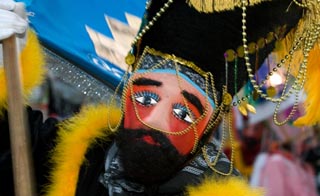
Celebrated 45 days before Easter (April 16th this year), Carnaval is a celebration of earthly, or carnal pleasures before the austerity and sacrifice of Lent. Beginning on the Friday before Ash Wednesday, Carnival reaches its climax on Mardi Gras — “Fat Tuesday.” Perhaps the most famous festivities are those of Rio de Janeiro and New Orleans. But there are lively celebrations throughout Mexico in more than 200 towns and cities.
With excellent weather all year round, Mexico is a great place to experience the excitement, music, dance and color of Carnaval. Here are our Top Ten picks for Carnival in Mexico, but there are many, many more.
10. Chapala
Set on Lake Chapala, the municipal seat includes charming Victorian architecture in the downtown area. The Carnival celebrations center on the park alongside the pier, but the action spreads to other towns on the north shore, such as San Antonio Tlayacapan and Ajijic. Festivities include rodeo events along with music and dancing, parades, carnival rides and more. Masked male dancers known as Sayacos wear wide hats and long beards, while others dress in drag, with wigs, beads and hugely padded breasts. The Sayacos predate the Spanish conquest of 1520.
9. Autlan
The little town of Autlan in the state of Jalisco celebrates Carnival in a big way. Birthplace of guitarist Carlos Santana, its festivities center on the bullfights, held in a special arena, while the music, dancing and fun continue in the streets.
8. Tlaxcala
This ancient city was founded in 1525. Although it is the state capital, the city isn’t large. Yet its Carnival is one of the most extravagant in Mexico. Elegantly dressed dancers known as Huehues take their name from Huehueteotl, the Aztec deity of wisdom and fire. While their masks are fair-skinned, their hats feature the feathers of indigenous headdresses. Tlaxcala’s delicious cuisine has a strong pre-Hispanic influence.
7. La Paz
In La Paz, Baja California Sur, Carnival is a ten-day party in the streets. Three gala parades, the coronation of the King of Happiness and a myriad of musical events keep spirits high. Set on a natural harbor on the Sea of Cortez, this town was founded as a Jesuit mission. Make time for whale watching and be sure to sample the exquisite seafood along with Baja-Med cuisine.
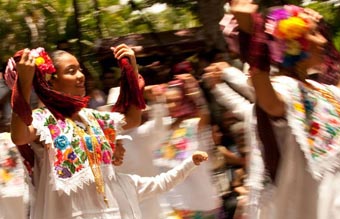
6. Tepoztlan
Located near Mexico City and Cuernavaca, Tepoztlan is a Pueblo Magico. The ancient town is considered a center of energy from the universe, and is home to mystics, clairvoyants, one of Mexico’s best midwives, and UFO sightings. During Carnival, its masked Chinelo dancers perform the Danza del Brinco, leaping lithely to the sound of flutes and drums.
5. Merida
The capital of Yucatan state, Merida’s colonial heart has a distinctively French feel. Indeed, until the mid-20th century, it was easier to reach New Orleans by sea than to travel from the Yucatan to Mexico City. Carnival in the “White City” is a family affair with theme parades, a king and queen, and salsa, mambo and cumbia dancing. The Battle of the Flowers is “fought” with lush tropical blossoms. Don’t miss the spectacular Maya pyramids outside the city.
4. Cozumel
An island off the Yucatan Peninsula, Cozumel was once the site of a Maya ceremonial center. Carnival festivities begin early here. Schools close and even children take part. Stay over for the superb snorkeling and diving to spots that Jacques Cousteau declared some of the most spectacular in the world.
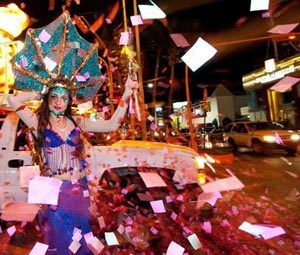
3. Mazatlan
The port of Mazatlan, in the northern state of Sinaloa, is famous for its Carnival. Different from any other, its festivities are accompanied by banda music, also known as tambora, a genre that originated in this state and is popular all over the country. This brass-based musical sound is very similar to the polka.
2. Campeche
Perhaps the oldest in Mexico, Campeche’s Carnival represents bad moods with the figure of a pirate. That makes sense, as pirates once preyed on Spanish ships laden with gold that set sail from the port. Unique to Campeche celebrations is the “Dance of the Pig’s Head.” One dancer carries a tray depicting the head of a pig. Attached to the tray, colored ribbons are held by other dancers.
1. Veracruz
Veracruz is the largest port in the country and, since colonial times, the most important connection with Europe. Celebrated since 1866 when Archduke Maximilian of Hapsburg ruled Mexico, Carnival here was originally held inside theaters or ballrooms. Today, it begins with the burning of a figure representing bad moods, and ends with the burial of Juan Carnival. The stately Danzón is a favorite dance.
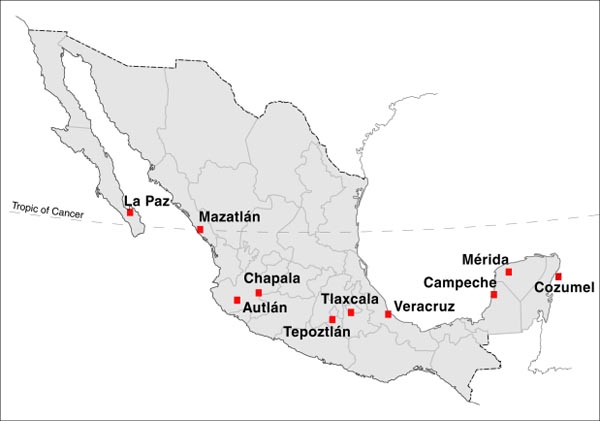

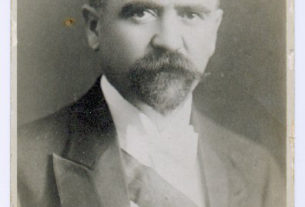
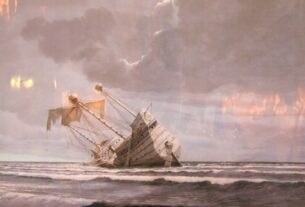
you miss the celebration in Cajititlan Jalisco, which is near Chapala jal. The village celebrates the Three Wise Men as they parade the three statues thru the village. the celebration take place from jan-1-7 ,most of the surrounding lake village attend the celebration , the lake is not as large as Lake Chapala. I feel it was worth a mention. sorry I am late just looking for article about Mexican History and events and tradition I only know them as I heard them.
I entirely agree that the Three Kings’ celebration in Cajititlán is a fantastic experience. However, it has nothing to do with annual Carnival celebrations (which are linked to the date of Easter each year) in various towns and cities of Mexico. We do have a short article about Three Kings Day – https://www.mexconnect.com/articles/3843-three-kings-day-in-cajititlan-mexico/ – and a more detailed article about the wonderful artisans of Cajititlán – https://www.mexconnect.com/articles/3882-mexican-artisans-of-lake-cajititlan/. Chapter 8 of my book, Western Mexico: A Traveler’s Treasury, is about Cajititlán and Three Kings. Book is available in English (and a Kindle edition in Spanish) via my Amazon author’s page – https://www.amazon.com/Tony-Burton/e/B00RC41D1M/.
ok